Original author: Ansgar Dietrich, Casparschwa, Ethereum Foundation
This article comes from Ansgar Dietrichs and Casparschwa's discussion on the Ethereum staking mechanism and ETH issuance model on the eth research forum. Geek Web3 sorted and edited this. These views were put forward in February 2024, and some data may be biased, but their analysis of the Ethereum staking economic model is still worth referring to, and some of the conclusions are still not outdated.
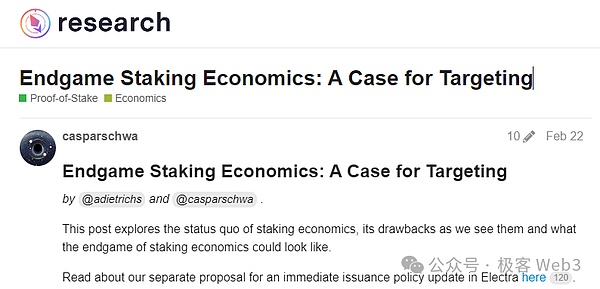
Main text:Currently30 million ETH have been pledged on Ethereum, accounting for 1/4 of the total (this is the data from February this year)This proportion is quite considerable, and it is still rising, with no signs of slowing down. The following figure shows the change of ETH pledge over time, and it can be clearly seen that it is showing a continuous growth trend, and this trend will continue for a long time.
In the future,a large part of the new ETH pledge will be affected by LST (liquidity pledge tokens), such as stETH.This will gradually increase the usage rate and currency attributes of LST, but this may bring negative effects.

First, LST has a network effect. Large-scale LST projects will erode all liquidity in the track, and eventually form a winner-takes-all situation, which will intensify the competition in the LST track. In addition, if LST surpasses ETH and becomes the mainstream currency on Ethereum except Gas Token, users will face counterparty risk brought by LST. The currency on Ethereum should be as trustless as possible to truly achieve economic scalability.
("Counterparty risk" refers to the possibility that the other party may default/fail to fulfill its obligations. "Counterparty risk" in the LST scenario mainly includes user asset theft, LST price slippage, and depreciation)
Currently, there is no hard upper limit for ETH staking. In theory, all ETH can be staked to obtain returns. LST significantly changes the cost structure of staking, and almost all ETH may be staked. Therefore, we believe that Ethereum's economic model and staking model should include dynamic adjustment policies to adjust the staking ratio within a certain range, so that Ethereum can ensure security at a controllable cost scale and avoid the generation of negative externalities. In this article, we raise some urgent issues that need to be addressed regarding Ethereum's economic model. Before discussing, let's first explore which long-term staking models are feasible under the current ETH token issuance policy. Ethereum's security depends on a certain proportion of token staking, which can be summarized as POS Ethereum itself has "demand to attract staking". The demand for staking is clearly stipulated in Ethereum's monetary policy. According to the actual staking weight, the protocol will adjust the ETH issuance accordingly to increase the staking reward for a single node.
However, the staking willingness of ETH holders is diverse and complex. We can only make reasonable inferences based on the existing information and roughly estimate the long-term impact of changes in staking willingness on staker participation.
The supply and demand curve of ETH staking: using additional ETH in exchange for security
Validator nodes staking ETH will allow the protocol to obtain security, and the protocol will then distribute token rewards to ETH stakers. This is a win-win mechanism. (Due to limited space, this article does not discuss specific issues such as "what level of security needs to be achieved". For details, please refer to the article Paths toward single-slot finality) The Validator's income mainly comes from two parts:
The first part:The rewards issued by the protocol according to a fixed yield curve; (that is, Ethereum distributes rewards to staking participants through the issuance of additional ETH each year)
The second part:The MEV income obtained by the Validator in the process of block production.
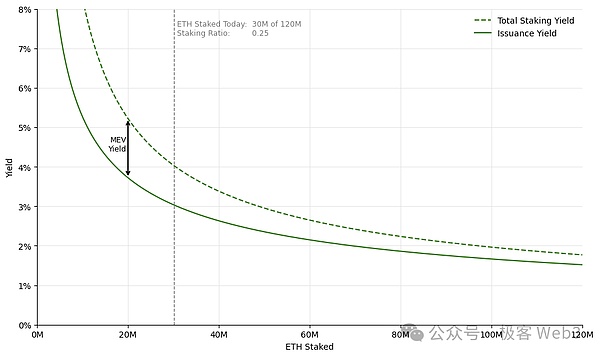
(The horizontal axis of this figure is the staking participation of ETH, and the vertical axis is the staking yield, which describes the staking yield that the Ethereum protocol is willing to provide to meet different staking rates. We can regard the Ethereum protocol as a buyer and the pledger as a seller)
Note: To understand the following content, readers may need to have a simple understanding of the supply and demand curve in economics.
ETH issuance yield curve (green solid line): It can be seen from the curve that as the number of pledgers increases, the staking rewards provided by Ethereum to a single node will gradually decrease. When ETH staking participation is low, the system needs to reward validators more to encourage more people to stake ETH; when more and more people participate in staking, the marginal contribution of a single validator to network security will decrease, and the demand for staking rewards will also decrease.
Total staking yield curve (green dashed line):The fixed increase in ETH income plus the MEV income constitute the total staking income of the staker.It should be noted here that the MEV yield is calculated as: the total amount of MEV income (about 300,000 ETH last year) divided by the total amount of ETH staked.
Since the total amount of MEV income is basically fixed, as the number of validators increases, the MEV yield will drop rapidly, and eventually the staking yield will approach the simple ETH issuance rate. It is worth noting that Ethereum's MEV income has been quite stable in the past period of time (refer to MEV-Boost Dashboard). Although this may change in the future, in order to simplify our discussion scenario, it is temporarily regarded as fixed.
From the above curve, we can read two key messages:
In order to avoid too low staking participation, Ethereum sets high returns when staking participation is low to attract more stakers.
The marginal utility of each staker decreases, that is, as the staking participation increases, the issuance rate of ETH tokens gradually decreases.
However, the above staking yield curve fails to ideally regulate the staking participation.First, the curve cannot effectively limit the threshold of the staking ratio. Even if all ETH is staked, the staking incentive will remain at about 2%. In other words, at the level of incentive design, Ethereum does not have precise control over the final staking ratio. In general, except for ensuring the minimum security of the system through high incentives in the initial stage, the protocol does not guide the staking level to a specific range.
It should be noted that the above mentioned are only nominal returns, and the dilution effect brought by the issuance of ETH itself is not taken into account. As more ETH is issued, the dilution effect will become more significant. For this reason, we will temporarily ignore the impact of the dilution effect and discuss it in detail later.
Supply-side analysis of ETH staking
The above discussed the demand curve for staking, that is, the staking income that the Ethereum protocol is willing to provide to meet different staking ratios. Now let's turn our attention to the supply curve. The staking supply curve shows the willingness of ETH holders to stake at different yields and reveals the conditions required for different staking participation.
In general, the curve will be upward-right sloping, which means that the network needs higher incentives to achieve higher staking participation. However, since the willingness to pledge cannot be directly observed or accurately measured, the shape of the supply curve cannot be specifically depicted, and we can only speculate through qualitative analysis.
In addition, the supply curve is not static. We will explore the changes in pledge costs over time and how this change affects the pledge decisions of ETH holders. In other words, changes in pledge costs will lead to the displacement of the supply curve, causing ETH holders' demand for pledge incentives to change.
We can only fit the historically observable pledge levels into an approximate pledge supply curve. The intersection of the demand curve and the supply curve at each specific time point reflects the actual pledge participation rate achieved in history.
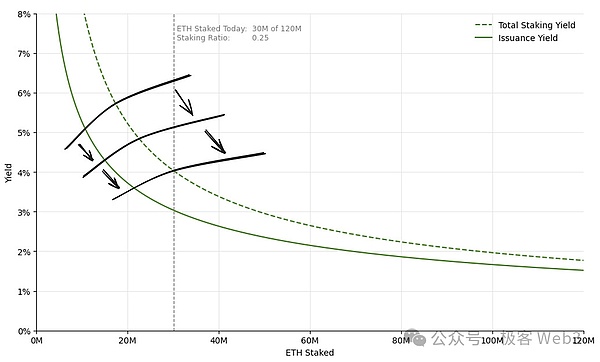
The horizontal axis of this figure is still ETH pledge participation, and the vertical axis is the pledge yield. As shown in the figure, since the launch of the Ethereum beacon chain, the total amount of ETH staked has continued to increase, and the supply curve of the staked amount has moved downward. Even at a lower staking yield, ETH holders' willingness to stake will still increase. From the historical trend, it is reasonable to expect the supply curve to continue to move downward in the short term. However, it is worth exploring the issue of long-term staking balance, and we need to carefully analyze the composition of the supply side.
When any ETH holder decides whether to stake, they usually consider two main factors: staking yield and required costs. In general, the staking yield per unit asset in the hands of validators is the same, but different types of stakers have significant differences in cost structure. The following will compare the differences between independent stakers and staking service providers (SSPs).
Independent stakers vs staking service providers
SSPs accept users' ETH and complete the staking operation on their behalf, charging a certain service fee. Typically, they provide users with LST as a pledge certificate, and users can use LST for secondary market transactions (such as stETH). For LST holders, the liquidity of these tokens depends on the overall usage rate of LST and the support rate of third-party protocols.
We want to focus on analyzing SSPs such as Lido that issue LST. As for those SSPs that do not issue LST, they can be regarded as special cases where the liquidity value of LST is zero and are not discussed in this article.
For most people, staking alone does not require trusting a third party, but the participation threshold is high and the operation is cumbersome; in contrast, LST requires a certain degree of trust, but has significant simplicity and liquidity advantages.

After comparing these two staking methods, we can draw two important conclusions:
1.There are obvious differences in the cost structure of independent staking among different ETH holders. The level of technical content, hardware conditions and operation and maintenance costs, as well as the confidence in the security of custody, all make the supply curve of independent stakers steeper. This means that if the number of independent stakers is to increase significantly, either the staking income must be greatly increased or the UX of the staking operation must be improved.
2.In contrast, the cost structure of users staking with SSPs is basically the same. The main difference is only reflected in the assessment of the operating risks of SSPs and the concerns about the slippage of the exchange between LST and ETH. Therefore, the supply curve of SSP is relatively flat. This means that to attract more ETH holders to stake LSD liquidity, the required yield increase is relatively small, and the stake participation rate can be expanded relatively smoothly.
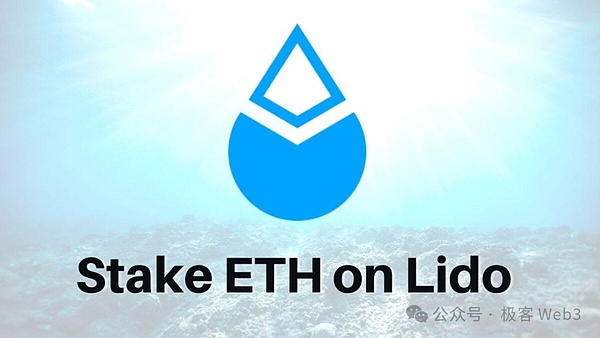
In addition, the cost of independent staking is not affected by the stake participation, while the cost of holding LST may gradually decrease over time and with the increase in the usage of SSPs, for the following reasons:
1. Enhanced "currency attributes" of LST: When the popularity of a certain LST increases, we can expect it to be supported by more and more projects, beyond the use scenarios of native ETH, such as more DeFi protocols integrating LST, and the second-layer network defaulting to liquidity staking for bridged ETH. When the ETH stake ratio is high enough, LST may even surpass unstaked ETH in terms of liquidity, reversing the liquidity gap between the two.
2. Reduced smart contract risk:Over time, LST's smart contracts will undergo a lot of practical tests, and the risks will be further reduced through formal verification and other methods.
3. Improved robustness of the governance system:With the increase in usage, LST-related governance mechanisms will become more mature and robust. For example, the LDO + stETH dual governance proposal reflects the progress of the LST governance system.
4. Reduced expectations of large-scale risks:When a certain LST occupies a large enough proportion of the overall market, it may be regarded as "too big to fail". Therefore, users believe that various forces in the market will remedy problems in SPPs in a timely manner.
5. Profit balance of LSD service providers:When the usage rate of LST is high enough to make its liquidity good enough, SSPs can reduce unit service fees to maintain profitability and attract more users to participate.
Overall, the existence of SSPs and LST has significantly flattened the staking supply curve, which means that there is no need to continue to increase staking incentives to promote the increase in the total amount of Ethereum staking. From this, it can be inferred that LSD will continue to play an important role in promoting the growth of staking. However, in this way, in the long-term time dimension, staking incentives are not the shackles of ETH staking growth, so how large can ETH staking reach?
Long-term equilibrium point of staking rate
Taking into account factors such as demand and supply, we can infer the long-term equilibrium state that ETH staking can maintain. As we mentioned earlier, when the staking participation rate is low, the demand curve shows an obvious tendency, but there is no clear conclusion about the specific staking ratio that may be achieved in the long term.
Then we explained that as the cost and risk of staking decrease, the supply curve will gradually shift down over time, making more and more people willing to participate in staking, and LST is the main driving force. However, the shape of the supply curve itself cannot be quantitatively analyzed, and it is not clear whether it is steep enough to reasonably adjust the staking participation.
Therefore, the equilibrium point of the overall staking ratio cannot be accurately calculated, and there is a wide range of possibilities, which may even be close to 100%. The figure below shows that even if the difference in the supply curve in the long term is small, it may cause the equilibrium point of the staking ratio to shift.
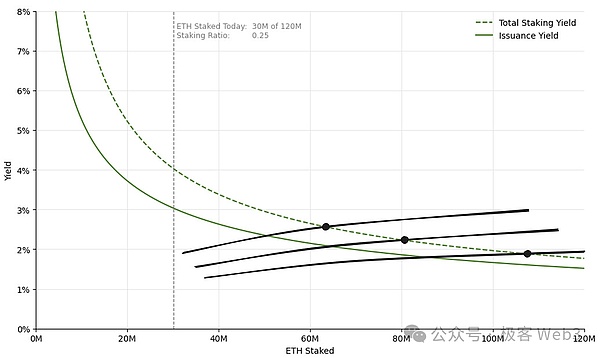
In fact, the most critical thing is not how high the staking participation rate will reach, but once such a high staking rate appears, it will bring a series of hidden dangers. This article proposes some policy adjustments to prevent this from happening.
Pledge ratio analysis: When is a lower pledge ratio better
The pledge ratio can be defined as the ratio of ETH pledged to the total supply of ETH. The current total supply of ETH is about 120 million, of which about 30 million are pledged, and the pledge ratio is about 25%. Before discussing the potential problems that a high pledge ratio may bring, we must first clarify a standard:
What level of pledge ratio can ensure the security of Ethereum. According to a previous discussion record of the Ethereum Foundation, we can know that the current pledge level is sufficient to ensure the economic security of Ethereum.
This leads to a question - If the current pledge ratio can already ensure network security, is it necessary to pursue a higher pledge ratio to achieve "over-security"? In our opinion, although high staking rates can enhance the security of the network, they may bring some negative externalities, affecting ETH holders, independent stakers, and even the operation of the entire Ethereum protocol.
Network Effect of LST Monetary Properties (LST): Risk Refusal
LSTs are in fierce competition for monetary properties. Due to the existence of network effects, this competition often presents a "winner takes all" situation. As the application areas of LST continue to expand, its practicality will increase, and its market share will gradually increase. The monetary properties of LST will be strengthened in many aspects, such as on-chain and off-chain integration, liquidity, and the ability to resist governance attacks.
In a high staking rate environment, if a single SSP controls most of the staking ratio, it is likely to be regarded as "too big to fail". If most ETH is staked at this SSP, it is difficult to effectively punish it. If a dominant SSP infiltrates the core of Ethereum protocol governance but does not have to bear corresponding responsibilities to users, this centralized governance risk will undoubtedly have a profound impact on the decentralization of Ethereum.

If most ETH participates in liquidity staking, in fact, in most scenarios except Gas Token, the real currency will be LST.However, whether LSTs are issued by ETFs, CEXs or on-chain staking pools, they are accompanied by different trust assumptions and have significant risks. In the end, users will inevitably bear additional risks from operators, governance, laws, and smart contracts, which is obviously not an ideal state.
In addition, although LST boasts that it can restore the liquidity of pledged ETH, its effect as collateral in DeFi is definitely not as good as native ETH. For the Ethereum network to achieve true economic scalability, its currency must be as trustless as possible, preferably using ETH itself.
Minimum Viable Issuance - Serving User Experience
Ethereum's minimum issuance MVI is the minimum issuance required by the Ethereum network while maintaining its security and functionality, aiming to balance the security of the network and the inflation rate of ETH. According to the MVI principle, sufficient staking participation must be ensured to ensure the security of the protocol, but the staking amount should not be too much.
When the staking level reaches a certain critical point, the security of the protocol is already solid enough, and the marginal utility brought by additional staking will gradually decrease, and even negative effects may occur (for example, increasing network load, diluting the rights of ETH holders, etc.). In addition, staking is a basic service required by a protocol, and the protocol should pay reasonable rewards for staking to attract users to participate, rather than forcing users to participate due to asset dilution pressure. If the issuance of ETH continues to increase, all ETH holders and stakers will face greater dilution risks, but SSP will not be negatively affected. Because the ownership of the pledged ETH does not belong to SSP, SSP only earns income by charging service fees, and the dilution of ETH value has nothing to do with it. Not only that, if more people participate in LSD staking to hedge against inflation, the service fees collected by SSP can rise. Assume a scenario: The participation rate of Ethereum staking is 90%, the annual yield of staking is 2%, the liquidity staking accounts for 90% of the total staking value, and the average SSP fee rate is 10%. In other words, 0.16% of the market value of Ethereum will be paid to SSP every year, which is about 200,000 ETH, which is about 530 million US dollars at the current price. This 530 million US dollars is actually equivalent to a hidden tax on all ETH holders.
Real yield: nominal yield - dilution effect
Similar to the nominal interest rate and real interest rate in finance, the real yield is the real yield after removing the dilution effect in the nominal staking income of ETH.With more and more people participating in staking and the inflation of Ethereum, the nominal income brought by ETH staking will gradually be diluted. The real income can more clearly reflect the real incentive of staking, and the staking yield curves we discussed before are all nominal yield curves.
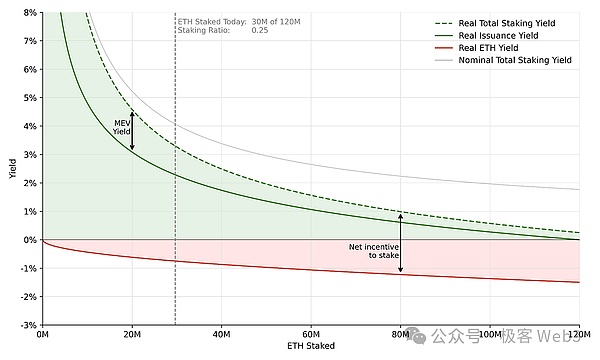
The above figure reflects the impact of the dilution effect on the income of stakers and non-staking ETH holders respectively. For ETH holders who do not stake (shown by the red line in the figure), since their nominal balance remains unchanged, but they suffer the dilution effect brought by inflation, their real income is obviously negative. To clearly describe this effect, we can analyze the staking ratio "S" in two cases.
When the staking ratio is low (left part of the curve), the actual yield curve (solid green line) is closer to the nominal yield curve (solid gray line). This is because there are fewer stakers and the protocol distributes fewer rewards by issuing more ETH, so the ETH inflation rate is very low and the dilution effect is relatively light. In this case, the main incentive for staking comes from positive returns, which is the green area in the figure.
When the staking ratio is high (right part of the curve), the gap between the actual yield and the nominal yield curve gradually increases. As more and more stakers participate, the issuance of ETH increases, and the dilution effect becomes more obvious. In addition to the reduction in actual returns, part of the incentive for stakers comes from "dilution protection", that is, hedging inflation through staking. In extreme cases, when the staking ratio is close to 100%, the actual return of staking will only consist of MEV returns. At this time, the inflation rate of Ethereum will be very high because it is necessary to continuously issue tokens to reward stakers.
To sum up, the biggest difference between high and low staking ratios is the different composition of staking returns. Under low staking ratios, users will obtain actual positive returns. After the staking ratio increases, due to the high inflation rate, users can only obtain less returns to offset the dilution effect, that is, "dilution protection". The higher the Ethereum staking ratio, the more newly issued ETH, and the higher the nominal return of the staking user, but high nominal returns do not mean high actual returns.
It should be emphasized that this change in the composition of returns does not reduce the incentive effect of staking. If you only look at the results, dilution protection and positive returns of real money are equally attractive to users. However, the two different types of returns have completely different meanings for users: When the staking ratio is low, staking is a profitable service paid for by the Ethereum protocol; on the contrary, when the staking ratio increases, staking becomes a helpless measure to hedge against inflation.
Therefore, if the staking ratio moves to the right to the highest, we may fall into a worst-case scenario: the actual returns provided by staking are extremely limited, and it also poses a threat of asset dilution to those who are unwilling to accept LST.
Any staker will definitely choose a strategy that actually yields higher returns for himself under the same staking policy. But in the design of Ethereum's protocol, users cannot choose at all, because the issuance curve of the protocol determines the final equilibrium state of staking (when the long-term staking supply curve is fixed). For the sake of income, any user can only choose to participate in the staking strategy.
Independent staking is less feasible
SSPs have fixed costs, and the more they stake, the lower the unit cost, which is naturally endowed with economies of scale. As the amount of ETH managed by SSPs increases, their marginal efficiency will also increase, which can lower costs and charge lower service fees, attract more users, and achieve higher profits. Based on these advantages, successful SSPs may be seen as "too big to fail", which reduces the tail risk they face and further strengthens the scale effect.
(Tail risk: the risk of extreme events, which have a very low probability, but once they occur, they often result in huge losses)
On the contrary, independent stakers need to bear all costs themselves, and the costs will not decrease with the increase in the amount of staked, but will increase with the increase in network load, which is one of the reasons why Ethereum passed the EIP-7514 proposal.
According to the previous analysis, as more and more staking income is used to hedge inflation rather than to obtain actual income, the actual income of the stakers is increasingly dependent on MEV, and the MEV income is highly volatile, which will cause the total income of independent stakers to fluctuate. In contrast, SSP can distribute the total MEV income proportionally to all Validator verification nodes it manages, effectively reducing the impact of staking income fluctuations on its overall operating results.
With the increase in the usage rate of LST and the enhancement of its monetary properties, the gap between independent staking and LSD staking will further widen. In other words, as the staking rate increases, the competitive disadvantage of independent staking compared to LSD staking becomes more and more significant.
In many jurisdictions, governments tax staking income based on nominal income rather than actual income adjusted for dilution effects. Through certain structural designs, LST can provide holders with certain protection from such tax effects, which independent staking usually cannot do. As the gap between nominal and actual returns grows, the income level of independent stakers is further left behind by LSD stakers.
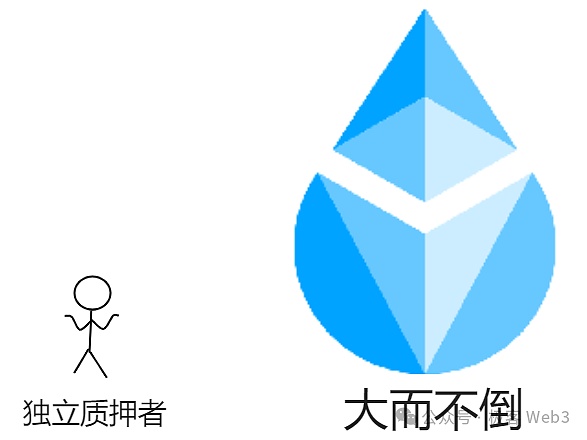
Based on this, we put forward the following views:
1. Holding native ETH should be economically viable, ensure a good user experience, and avoid value dilution caused by security risks, so as to better protect the interests of ETH holders.
2. In order to achieve true economic scalability, Ethereum's universal currency should be as trustless/trustless as possible. Only in this way can the robustness and wide applicability of the entire system be ensured.
3. The dilution protection of asset value has become the main incentive component of staking, which is an undesirable result for both stakers and ETH holders. Relying on dilution protection as an incentive may bring unnecessary market volatility and weaken the original intention of the staking mechanism.
4. A high staking participation rate will further aggravate the competitive disadvantage of independent stakers in the market, and may make more users tend to use SSPs for staking, resulting in the centralization of staking, which is not conducive to the decentralization and security of the network.
The staking ratio that Ethereum can achieve in the future is still uncertain. We need to take proactive measures to determine an optimal staking ratio to prevent a high ratio from having a negative impact. Even if a high staking ratio may be beneficial to some people, this choice should be made after full consideration, rather than being randomly affected by external market factors.
The ultimate goal of the staking participation ratio
I believe that Ethereum's staking policy should be based on the staking ratio, rather than the amount of ETH staked. ETH supply fluctuates due to EIP-1559 and the issuance mechanism, and the staking ratio can adapt to this supply change. Although the current ETH supply changes very slowly, declining by about 0.3% per year since The Merge, its long-term impact cannot be ignored. A policy based on the staking ratio can maintain stability over a longer period of time without frequent adjustments.
As mentioned above, although the current issuance curve ensures a minimum level of staking, it lacks a mechanism to limit the upper limit of the staking ratio, which may lead to an excessively high staking ratio. We believe that a sound token issuance policy should set upper and lower limits on the staking ratio to ensure network security and maintain reasonable participation. Specifically, the policy should strive to keep the staking ratio within an "optimal range that ensures network security while avoiding negative externalities."
To this end, Ethereum can set super-high rewards for too low staking ratios, and super-low rewards or even negative rewards for too high staking ratios to adjust the staking ratio. In this way, Ethereum can regulate staking participation. The curve of this policy design can refer to the example proposed by Vitalik, which shows how to adjust rewards under different staking ratios to guide staking behavior.
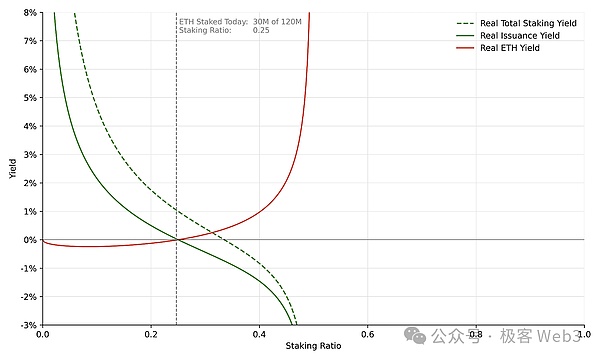
As shown in the issuance curve in the figure, the rewards are generous when the staking participation is low, which is consistent with the current policy. As the staking participation increases, the staking income gradually decreases until it turns negative. In other words, the income from staking will eventually decrease to the point where it is no longer attractive, thereby inhibiting staking behavior. However, this negative return state will not last long. The participation in staking will gradually decrease due to the regulation of this mechanism and reach equilibrium at a suitable level. Therefore, the model that presents this yield curve law can ensure that the staking ratio is maintained within a reasonable range. In fact, to achieve a reasonable staking ratio range, it is not necessary to choose a curve where the yield quickly turns negative. Those curves that only control the staking rewards at zero or close to zero after a certain critical point may be enough to achieve the same effect, which can not only suppress over-staking, but also maintain the stability of the system. The impact of determining a reasonable staking ratio range The advantage of determining a reasonable staking ratio is that it can effectively avoid various negative effects caused by a high staking rate. However, this strategy is not without disadvantages. An obvious example is that the rewards faced by independent stakers in this case are volatile. Similar to the environment with high pledge rate, under the strategy of determining a reasonable pledge ratio, a large part of the incentive source is MEV income, which will increase its volatility.
Therefore, although there are many advantages to determining the range of pledge ratios, it may also increase the volatility of income that already exists. MEV risk can be solved by introducing mechanisms such as Execution Tickets or MEV Burn, or by setting pledge fees to balance the volatility of income to a certain extent. Some people also oppose setting the pledge ratio within a certain range. One representative view is that doing so may reduce the overall equilibrium income, thereby intensifying the competition between independent pledgers and SSPs, as well as the competition between different SSPs.
The logic of opponents is that the overall equilibrium income reduction leads to insufficient capital supply. The pledge form adopted by some SPPs may be more beneficial to the Ethereum protocol, but due to the lack of competitiveness of their projects, it is difficult to survive with sustained profitability, resulting in lower overall utility of Ethereum. To deal with this problem, it is still necessary to distinguish between nominal income and actual income.
Although the strategy of determining the range of pledge ratios may reduce nominal returns, the actual returns may not be affected. The following diagram further illustrates this point.
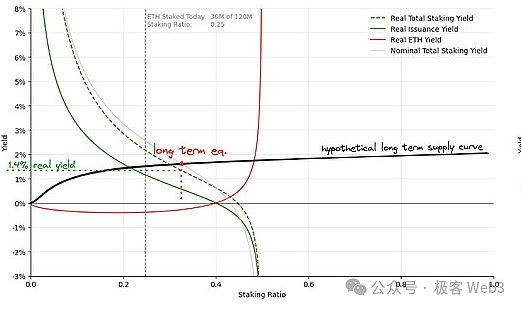
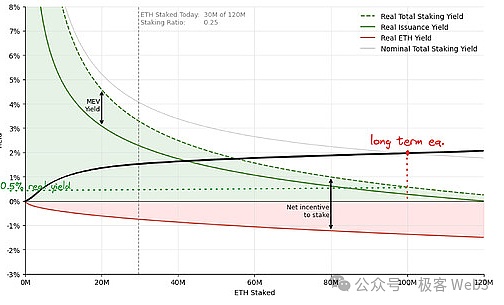
The above figure shows the scenario of the system reaching long-term equilibrium when a certain range of pledge ratios is adopted, and the figure below roughly shows the scenario under the current Ethereum token issuance curve. Both examples are based on the same assumption: about 100 million ETH are involved in staking, that is, the long-term staking supply remains consistent, so this comparison is meaningful.
In the figure below, most of the staking incentives are used for dilution protection, so the actual yield is only maintained at about 0.5%. In the left scenario, the system reaches a lower nominal yield equilibrium point, but due to the lower inflation rate, the actual yield will increase to about 1.4%.
This example clearly shows that determining the range of staking ratios will reasonably increase the actual yield and ease the competitive pressure among stakers. In addition, this is also beneficial to ETH holders who do not participate in staking because it can minimize the risk of dilution.
Open Questions
The strategy proposed in this paper is to determine a reasonable staking ratio. However, there are some urgent problems to be solved.
1. What is the ideal range of staking ratios?
For staking ratios, we have discussed the unideal range, but have not clearly proposed the ideal staking ratio range. In fact, this issue is quite complex and requires in-depth discussion within the community, and will refer to some opinions of Vitalik and Justin.
The core of the problem lies in the trade-off - lower staking participation increases the risk of the protocol being attacked, while too high staking participation may bring negative externalities. In order to better determine the staking range, we can model the utility under different staking ratios. A possible utility curve is shown below:
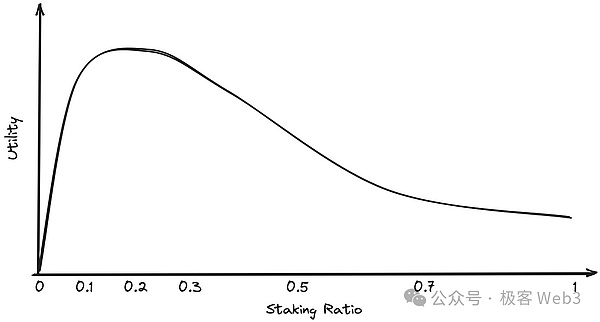
2. How to choose a suitable staking yield curve to achieve the target range?
After determining a reasonable staking ratio, the designer must also choose a suitable staking curve to achieve a balance in Ethereum staking participation. Designers should carefully evaluate the advantages and disadvantages of different curves and pick the most suitable solution. At the same time, designers can continue to explore other mechanisms, such as a feedback control system similar to EIP-1559, which dynamically adjusts the pledge issuance curve according to network conditions to ensure that the curve is optimally matched with network demand.
3. How to ensure incentive compatibility in the case of near-zero or negative issuance?
Incentive compatibility was proposed by Nobel Prize winner Leonid Hurwicz and is an important principle of mechanism design. Specifically, if a certain mechanism can unify the personal interests within the system with the overall interests of the system, the system is incentive compatible.
The original intention of Ethereum PoS issuance was to attract validators to participate in consensus through economic incentives. However, under certain pledge participation rates, the issuance income may approach zero or even become negative. Although in this case, validators may continue to stake for MEV income, if there is a lack of regular staking rewards, the verification nodes may lack sufficient motivation when producing blocks and verifying. That is to say, when the staking issuance is too low, the consensus mechanism may face the risk of failure.
To solve this problem, the Ethereum protocol can charge a certain fee to all validators and redistribute it according to whether the validator is competent to re-establish incentive compatibility. However, the implementation of this solution will increase the complexity of the protocol, so its feasibility and effectiveness need to be further explored.
4. How to set the target range in a relative (staking ratio) rather than an absolute (fixed ETH number) way?
In fact, the staking issuance level can also be set to a certain absolute ETH number, such as 30 million or 40 million ETH. However, in order to make the issuance policy more forward-looking and adaptable, it is best to directly use the staking ratio as an assessment parameter. In order for the issuance policy to target a specific staking ratio, the protocol needs to control the amount of ETH staked and the supply.
5. When the staking participation rate exceeds the target range, how to restore it to the target value?
If the current staking participation rate is within the target range, it is of course the best situation, but if it exceeds the range, certain measures must be taken to reduce the staking participation rate, so that some stakers will not be able to earn enough and then quit staking. Even if we use the most moderate means to reduce participation, this process will have an adverse impact on some stakers. How to minimize this impact is still a problem that needs to be solved.
Conclusion
We discussed the current Ethereum staking incentive policy and token issuance plan, explained in detail the negative externalities of the issuance plan, and explored a new policy that can solve the problem, which is to set the staking ratio within a target range.
However, given some unresolved issues, especially the lack of validator fee mechanism and on-chain MEV capture mechanism, it will take some time for this policy to be implemented. We propose to reform the current ETH staking and token issuance policy during this period as a key step towards the target policy.
To this end, we have proposed a proposal to reform the staking issuance policy in the upcoming Electra upgrade (for relevant content, please refer to the article Electra:Issuance Curve Adjustment Proposal).
 JinseFinance
JinseFinance




















